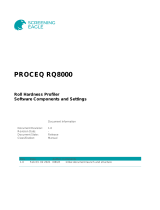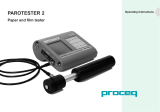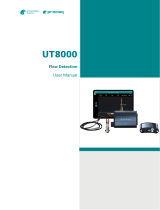Page is loading ...

This document is the property of Screening Eagle Technologies (SET) and must not be used, copied, re-printed nor duplicated
totally or partially without the prior written consent of SET.
The authors of this document have done their best in preparing this document. These efforts include the development, research,
and testing of the theories and measures to determine their effectiveness. The authors and SET make no warranty of any kind,
expressed or implied, with regard to the documentation contained in this report. The authors and SET shall not be liable in any
event for the incidental or consequential damages in connection with, or arising out of, the furnishing, or use of the documentation
contained in this document.
Proceq SA T +41 43 355 38 00
Ringstrasse 2 | CH-8603 Schwerzenbach, Zurich | Switzerland ScreeningEagle.com
RQ8000
Paper Roll
Quality Tester
Technical Manual
Document Revision: 1.01
Revision Date: -
Document State: Released
Company: Proceq SA
Ringstrasse 2
CH-8603 Schwerzenbach
Switzerland
Classification: Manual
For internal use only.

This document is the property of Screening Eagle Technologies (SET) and must not be used, copied, re-printed nor duplicated
totally or partially without the prior written consent of SET.
The authors of this document have done their best in preparing this document. These efforts include the development, research,
and testing of the theories and measures to determine their effectiveness. The authors and SET make no warranty of any kind,
expressed or implied, with regard to the documentation contained in this report. The authors and SET shall not be liable in any
event for the incidental or consequential damages in connection with, or arising out of, the furnishing, or use of the documentation
contained in this document.
Proceq SA T +41 43 355 38 00
Ringstrasse 2 | CH-8603 Schwerzenbach, Zurich | Switzerland ScreeningEagle.com
Document Information
Document Revision: 1.01
Revision Date: -
Document State: Released
Company: Proceq SA
Ringstrasse 2
CH-8603 Schwerzenbach
Switzerland
Classification: Manual
Revision History
Rev
Date
Author
Comments
0.8
Sep 27, 2020
PEGG
Initial document
0.9
Oct 1. 2020
DBUR
Corrections
1.0
Oct 07 2020.
DBUR
Corrections and images
1.01
Oct 20 2020.
DBUR
Corrections and images

RQ8000 Technical Manual
© Copyright 2020, PROCEQ SA
Content
1 INTRODUCTION ………………………………………………………………………………... 3
1.1 Scope of this document
2 System Parts.................................................................................................................... 4
2.1 RQ8000 measurement system
3 Measurement Head usage ............................................................................................... 6
3.1 Measurement head layout
3.1.1 Switches and connectors
3.2 Batteries and Recharging
3.2.1 Inserting Batteries
3.2.2 Recharging Batteries
4 Measurement and Calibration ......................................................................................... 8
4.1 Performing a measurement
4.1.1 Turning the power on and off
4.1.2 Using the barcode reader to read a new roll tag
4.1.3 Using the barcode button to create a new roll tag from scratch
4.1.4 Measurement
4.2 Measurement Speed
4.3 RQ8000 Calibration Sample (optional)
5 Software Overview and Usage ...................................................................................... 10
5.1 File Management
5.2 Analysis Software
5.2.1 Builder
5.2.2 View Component
5.2.3 Main Control and Settings
6 Specifications ................................................................................................................ 16

RQ8000 Technical Manual
© Copyright 2020, PROCEQ SA
Legal Notices
This document can be changed at every time and without any prenotification or announcement.
The content of this document is intellectual property of Proceq SA and prohibited to be copied
neither in a photomechanical or electronic way, nor in excerpts, saved and/or be passed on to
other persons and institutions.
The features described in this inst
ruction manual represent the complete technology of this
instrument. These features are either included in the standard delivery or available as options at
additional costs.
Illustrations, descriptions as well as the technical specifications conform to the instruction manual
at hand at the time of publishing or printing. However, Proceq SA policy is one of continuous
product development. All changes resulting from technical progress, modified construction or
similar are reserved without obligation for Proceq to update.
Some of the images shown in this instruction manual are of a pre-
production model and/or are
computer generated; therefore the design/features on the final version of this instrument may
differ in various aspects.
The instruction manual has be
en drafted with the utmost care. Nevertheless, errors cannot be
entirely excluded. The manufacturer will not be liable for errors in this instruction manual or for
damages resulting from any errors.
The manufacturer will be grateful at any time for suggest
ions, proposals for improvement and
references to errors.

RQ8000 Technical Manual 3 / 19
1 Introduction
The RQ8000 Roll Quality Tester is designed for fast and accurate measurement of paper roll and
machine roll hardness profile.
This hand-held measurement device includes hardness measuring unit and distance encoder. Paper
reels with non-uniform hardness profile may cause problems when printed or converted.
RQ8000 is the fastest and the most accurate system to detect reels that need to be excluded in printing
or converting processes.
1.1 Scope of this document
This document is an instruction manual for the RQ8000 Roll Quality Tester. It describes in
technical details, the use of the RQ8000 and the its PC software.

RQ8000 Technical Manual 4 / 19
2 System Parts
2.1 RQ8000 measurement system
Each RS8000 Roll Quality Measurement system comes with a sturdy padded carrying case
containing:

RQ8000 Technical Manual 5 / 19
The following parts are included in the delivery:
Content
1 RQ8000 Wireless measurement device
4+4 Rechargeable AA batteries (preferably removed from the RQP before
packing)
1 Battery charger + power cord
1 Car power adapter
1 SD Card
1 USB cable type A-B
1 USB memory stick with RQ8000 software and drivers
1 Plastic strip
2 Allen key and spare screws
1 RQ8000 – Quick Start Guide in Printed version

RQ8000 Technical Manual 6 / 19
3 Measurement Head usage
3.1 Measurement head layout
3.1.1 Switches and connectors
Barcode reader direction indicator
Power button
Barcode reader button/add new roll tag
SD card slot
USB connector
3.1.2 Indicator LEDs
Power status
SD card operation
Barcode reader status
Bluetooth link
USB connection
3.2 Batteries and Recharging
3.2.1 Inserting Batteries
RQ8000 unit is powered by four rechargeable type “AA” batteries.
Only use rechargeable AA batteries due to the unit’s built-in recharging function.
Reliable measurement requires that the NiMH batteries are in good condition and that the capacity of
the batteries should preferably be 2000mAh or more. Alkaline or other disposable non-rechargeable
batteries are not to be used with RQ8000 measurement system.
The battery cover has a rotating lock system and plugs in and out to reveal the batteries. The metal part
in the middle of the cover is the locking system which can be rotated with a coin or a similar tool. The
operation should be smooth when the battery cover is pressed against the RQP's metal surface. The
springs support the batteries and the locking system ensures a tight fit.

RQ8000 Technical Manual 7 / 19
Make sure that the batteries are inserted in the correct direction of polarity, there is a check-up drawing
located near the battery lid (below):
Study the overview of the battery compartment with the lid removed. The visible ends of the inserted
batteries should correspond to the ones in the drawing next to it
(+ being the one with the knob, - being the more flat-ended one.)
When packing up the RQ8000 to its carrying case for transporting the measurement system to another
location it is advised that the batteries should be removed from the battery slot and packed separately.
This way the measurement device does not switch on by accident resulting in lowered charge or drained
batteries and also the rechargeable batteries have a lower risk of self-discharging. This is also the
recommended procedure when the measurement device is going be left alone in storage for longer
periods of time.
With the batteries removed the real-time clock of the RQ8000 device loses the correct time in 2-4 weeks.
If this is the case it is recommended that the RQ8000 is connected to the PC before making a
measurement. By doing this the correct time is set and the timestamps of the measured files are correct.
3.2.2 Recharging Batteries
There are two methods of keeping RQ8000 batteries loaded and ready for measurement.
Every RQ8000 unit is supplied with an external battery charger which allows the user to recharge the
batteries outside the RQ8000 unit. When using an external charger to charge your batteries make sure
that you charge them to full capacity before inserting them back to the RQ8000.
Another method is the USB charge. When the RQ8000 is connected to the computer with a USB cable
the unit will recharge the AA batteries inside the unit. This recharge method is usually slower than
recharging with a separate, dedicated AA recharger but USB recharge is sufficient for keeping the
RQ8000 unit measurement ready for occasional measurements.
The usual measurement-recharge ratio for USB charge is 20% vs 80%, if the unit gets one hour of
measurement time it should get four hours of USB recharge to get fully recharged. Please check that
your RQ8000 unit supports USB charging before using this option.
NOTE: Because of the USB charging function it is extremely important that the batteries are always
correctly aligned and only rechargeable AA batteries are used with RQ8000 unit.
If the batteries are not intended for recharging they may overheat or even explode and inflict
serious damage to the RQ8000 unit and its surroundings.

RQ8000 Technical Manual 8 / 19
4 Measurement and Calibration
4.1 Performing a measurement
4.1.1 Turning the power on and off
Start up the RQ8000 with a short press of the power button marked with .
All LEDs are lit for a short period and the device should be ready for measurement with the power LED
turned green.
You may choose to read a barcode from a roll (as instructed in section 3.2), create a new roll tag from
scratch with barcode/new roll button (3.3) or proceed to the actual measurement (section 3.4.)
4.1.2 Using the barcode reader to read a new roll tag
The barcode button activates the camera which is used to acquire barcode information from a roll label.
The barcode distance should optimally be some 10-20 centimeters away from the front end of the
RQ8000and the green line projected to the surface should be visible and uniform. The barcode does
not need to be in line with the guided line nor does the RQP need to be turned to a similar angle, the
camera is able to read barcodes from any direction. To ensure fast recognition of the barcode the RQP
device should be directed towards the barcode while starting the reading.
The Barcode LED should flash a green light when a barcode is successfully recognized. If the
LED blinks red the device was not able to recognize the barcode before timeout.
You may retry by pushing the same button .
4.1.3 Using the barcode button to create a new roll tag from scratch
If the measured rolls do not have barcode IDs but you wish to create a marker to separate your
measurements from each other (for different rolls for example) you can press the barcode reader button
to mark them. This will create a separate directory for a measurement or a group of measurements
each time the button is pressed.
4.1.4 Measurement
Place the RQ8000on the surface or roll you wish to measure and move the measurement head forward
with firmly holding it against the surface. The hammer will hit rapidly while the distance wheel is turning
and the required force against the wheel is detected.
Keep the movement steady and make sure that you have a firm grab of the measurement head when
moving it over the edge of a roll.
If the measured surface or the length of the measurement is extremely short then the preferred method
of ending a measurement of a profile is to stop moving the head forward and to lift the measurement
head away from the surface.
The measured profile is now saved to the SD disk.
4.2 Measurement Speed
RQ8000 measurements are considerably faster than other methods of roll profile measurement. For
optimal results the measurement has to be steady and controlled and if the analysis requires more data
this can easily be achieved by slowing down the measurement speed. For normal measurements the
speed may be something from 5cm per second and for very precise measurements the speed can be
as low as 1cm per second. This will result to more measurement points and larger data to be analysed.

RQ8000 Technical Manual 9 / 19
4.3 RQ8000 Calibration Sample (optional)
With the RQ8000 Calibration Sample the operator can easily check that the RQ8000 unit has retained
its measurement level.
The calibration sample is a standard surface with a good glide attached inside a sturdy metal enclosure.
When performing a calibration sample measurement the movement speed should be closer to 1cm per
second. For optimal results the calibration sample is measured twice without lifting the unit from the
surface, please review the picture below.
This will allow the measurement to have more data for accurate border recognition. The displayed
calibration profile will be from the first sweep.
If you would like to purchase a calibration sample for your RQ8000 unit please contact Proceq for further
details.

RQ8000 Technical Manual 10 / 19
5 Software Overview and Usage
The following will describe how to manage and analyze the measured data.
More detailed information about measurement and data analysis can be found on a separate
document provided on the USB stick that comes with the RQ8000 unit.
5.1 File Management
The RQ8000 installation program registers the roll file types so that they can be manipulated directly
from the Windows Explorer.
When the RQ8000 software is running double-clicking on a measurement file will analyse the file with
the software.
You can recognize the roll files from their type (file extension) or by their icons (below):
Data of multiple rolls, multiple profiles in view
Data of a single roll, a single profile

RQ8000 Technical Manual 11 / 19
5.2 Analysis Software
The main components of the RQ8000 are the file Builder, Device Control, Main Control, Recent Builds
and the View Component window(s).
5.2.1 Builder
Builder has an user interface including:
Build path control
Any changes on path will start build action of the directory
Build path may be selected using standard windows file selector
Double click the .roll file to change the build path and start build action

RQ8000 Technical Manual 12 / 19
Explore button
Will open windows explorer window for the current build path
Recent Builds
shows a history and user defined permanent build paths enabling quick browsing of latest
measurements.

RQ8000 Technical Manual 13 / 19
5.2.2 View Component
5.2.3 Main Control and Settings
Clicking on the Main Control window Settings button opens up the Settings dialog

RQ8000 Technical Manual 14 / 19
Double-click on the desired setting change or right-click to select if the setting is to be changed on all
instances
Click on the setting and select the value from drop down menu or type in the numeric value
Verify the value and click OK or CANCEL

RQ8000 Technical Manual 15 / 19
The changed value is marked with an asterisk (*) and also the heading has one if any of the settings is
changed from the last applied one. Apply the setting with APPLY or OK. If you would like to cancel the
setting change(s) at this stage you may click CANCEL

RQ8000 Technical Manual 16 / 19
6 Specifications
Main features
Measurement frequency:
30Hz, 30 hits/s
Measurement range:
adjustable
Connectivity
Removable Media:
Secure Digital (SD) card up to 2GB
Wireless:
Bluetooth v2.0, range up to 30m
Wired connection type:
USB
Barcode Reader:
Built-in camera with illumination, various formats supported
including linear, stacked linear and matrix bar (QR codes),
range 1-30cm
Battery
Type:
4 x AA flight-safe batteries, rechargeable. Capacity 2500mAh
(2000mAh for low self-discharge) or better per battery
Measurement time:
2 hours (continuous)
Standby time:
5 hours (up to)
Charger:
external, any standard AA charger can be used
internal, with USB connection
Physical Dimensions
Size:
190x75x105mm (H x W x D)
Weight:
1.25kg (incl. batteries)

RQ8000 Technical Manual 17 / 19
/











